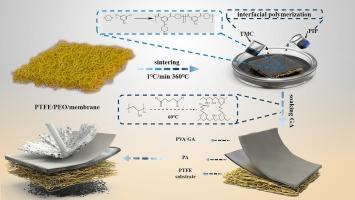Constructing a dual-layer PTFE nanofiltration membrane for enhanced salt solution permeability
IF 9.8
1区 工程技术
Q1 ENGINEERING, CHEMICAL
引用次数: 0
Abstract
Polytetrafluoroethylene (PTFE) nanofiltration (NF) membrane has gained increasing attention due to its comprehensive outstanding performance. However, the inherent low surface energy of PTFE makes it difficult to construct a functional NF layer on its surface. In this study, we have presented a novel three-layer of PTFE composite NF membrane with the electrospun PTFE nanofiber membrane as the substrate. During which, the cross-linked polyvinyl alcohol (PVA) was utilized to ensure the high adhesion strength between the polyamide (PA) selective layer and the substrate of PTFE nanofiber membrane. Furthermore, we have further optimized the physical and chemical structure of the composite NF membrane by adjusting the structure and thickness of the PA selective layer and the PVA-GA (glutaraldehyde) layer. When the TMC (1,3,5-benzenetricarbonyl trichloride) and PIP (piperazine) concentration were 2 % and 6 %, the PVA concentration was 2 %, the obtained composite membrane achieved a high multivalent salts rejection rate (99.2 % for Na2SO4) and permeation flux (14.41 L∙m−2∙h−1∙bar−1). Additionally, the obtained PTFE composite NF membranes demonstrated durability against solvents and long-term reliability after ultrasonic treatment, acid/alkali treatment, sustained operation for 48 h, and cyclic experiments. These findings offer a practical method for the industry's utilization of PTFE NF substrates in the separation of salt solutions.

制备双层聚四氟乙烯纳滤膜提高盐溶液渗透性
聚四氟乙烯(PTFE)纳滤膜因其综合性能优异而受到越来越多的关注。然而,聚四氟乙烯固有的低表面能使得在其表面构建功能性的NF层变得困难。本研究以静电纺聚四氟乙烯纳米纤维膜为基材,制备了一种新型的三层聚四氟乙烯复合纳滤膜。在此过程中,利用交联聚乙烯醇(PVA)保证聚酰胺(PA)选择层与聚四氟乙烯纳米纤维膜基底之间的高粘附强度。此外,我们通过调整PA选择层和PVA-GA(戊二醛)层的结构和厚度,进一步优化了复合纳滤膜的理化结构。当TMC(1,3,5-苯三羰基三氯化物)和PIP(哌嗪)浓度分别为2%和6%,PVA浓度为2%时,所制备的复合膜具有较高的多价盐截留率(对Na2SO4的截留率为99.2%)和较高的渗透通量(14.41 L∙m−2∙h−1∙bar−1)。此外,经过超声波处理、酸/碱处理、持续运行48小时和循环实验,所获得的PTFE复合NF膜具有耐溶剂性和长期可靠性。这些发现为工业上利用聚四氟乙烯基板分离盐溶液提供了一种实用的方法。
本文章由计算机程序翻译,如有差异,请以英文原文为准。
求助全文
约1分钟内获得全文
求助全文
来源期刊

Desalination
工程技术-工程:化工
CiteScore
14.60
自引率
20.20%
发文量
619
审稿时长
41 days
期刊介绍:
Desalination is a scholarly journal that focuses on the field of desalination materials, processes, and associated technologies. It encompasses a wide range of disciplines and aims to publish exceptional papers in this area.
The journal invites submissions that explicitly revolve around water desalting and its applications to various sources such as seawater, groundwater, and wastewater. It particularly encourages research on diverse desalination methods including thermal, membrane, sorption, and hybrid processes.
By providing a platform for innovative studies, Desalination aims to advance the understanding and development of desalination technologies, promoting sustainable solutions for water scarcity challenges.
 求助内容:
求助内容: 应助结果提醒方式:
应助结果提醒方式:


